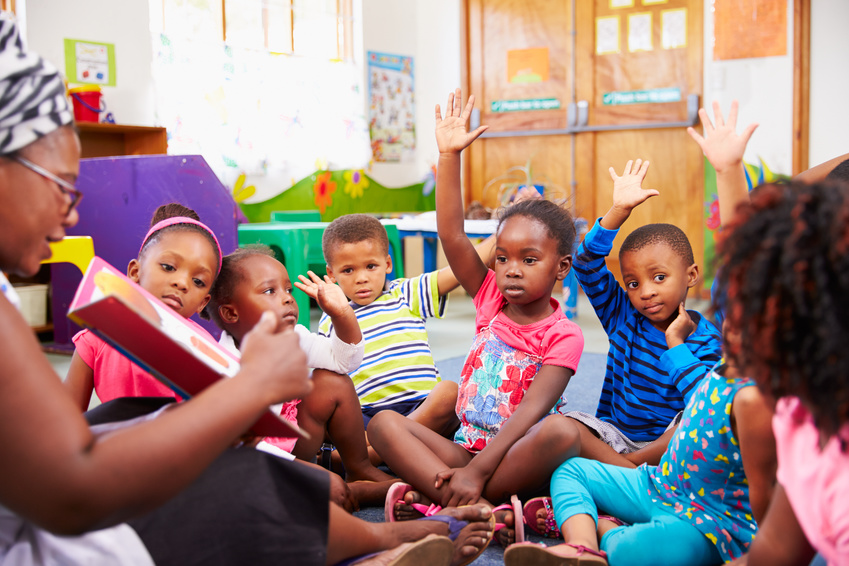Imagine that you, a teacher, are preparing to read a book to a child or group of children and you want to use the story as an opportunity to develop their understanding of math. This document contains some general tips for doing this.
General Guidelines
First, decide what math concepts you want to cover. Then choose a picture book that will allow you to teach or review that content. See below for a list of recommended picture books for each content domain.
Preparing to Read
Before reading to the child, read the book yourself until you are comfortable with the story and feel confident that you can read it aloud smoothly. Try to look at the book from a child’s perspective. Are there any tricky words or illustrations that might cause confusion? Do the illustrations help the reader to understand the text or are they unclear? Be prepare to address such problems if they arise.
Plan your questions in advance. Write them down on post-its that you can stick directly on the pages or on the back of the book. You can also write them on a separate piece of paper that you keep nearby so you can refer to them while reading.
During Reading
 The following general principles for reading a storybook with a child or group of children apply whether you are reading a math storybook or a non-math storybook. The general objective is to stimulate children’s engagement by asking questions that promote both understanding and expressive language. The goal is not to read to a captive audience but to engage with children in an effort to promote their understanding, analysis, language, and enjoyment of what is read.
The following general principles for reading a storybook with a child or group of children apply whether you are reading a math storybook or a non-math storybook. The general objective is to stimulate children’s engagement by asking questions that promote both understanding and expressive language. The goal is not to read to a captive audience but to engage with children in an effort to promote their understanding, analysis, language, and enjoyment of what is read.
Read a book several times
At the outset, you want to make sure that the children have a good idea about the storyline, and that they enjoy it. For these reasons, you may wish to read the entire story straight through the first time, with few questions for the children (although they may have some for you). On later readings, you can ask questions or focus on relevant parts of the story in other ways. But don't lose sight of the story!
Ask questions
Asking questions actively engages children and provides insight into their understanding of the story. As appropriate, ask a variety of question types, both concrete and abstract. Answering the concrete questions requires careful observation of the scene on a page. Answering abstract questions requires thinking about the scene or other contexts. Either type of question may be appropriate depending on the particular page of a book and on the child’s abilities, experiences, and other individual factors.
- Lower-level questions are relatively simple and concrete, addressing what children see directly on the page as well as key words from the text that you think they might not understand. For example:
- Recall: What animals have climbed on the seesaw so far?
- Label: What is this animal called?
- Describe: How many animals do you see? What are the animals doing on this page?
- Higher-level questions are relatively complex and abstract, asking children to engage in deep thinking and go beyond the literal events on the page. For example:
- Predict: Do you think the elephant will ever get off the ground? How?
- Infer: Why do you think the seesaw hasn’t moved, even after all these animals climbed on the other end?
- Summarize the story across multiple pages: Has anything changed from the beginning of the story to the end?
Explore children's responses
Expand on children’s thinking by elaborating on their responses and asking follow-up questions. Listen to the children’s comments. Even though you have planned your questions, follow the children’s interests and let them lead the conversation when they have interesting observations.
Model complex thinking
As they grow and develop, children learn increasingly complex ways of thinking. One way they learn is by listening to you, the adult, model thinking about the story.
After Reading
After finishing the book, engage the children in a discussion about the story. Ask them to recall what the story was about or describe their favorite character or scene. Continue to connect the story to the children’s lives. Using new vocabulary and concepts in a variety of contexts help children better understand the words and ideas.
Then re-read the story! Children not only enjoy listening to a story more than once, they benefit from repeated exposure to new vocabulary words and repeated opportunities to understand complicated or novel ideas. You don’t need to re-read the story right away, but you can come back to favorite stories anytime.
Young children benefit from many experiences. After reading, you can plan activities to extend their explorations of the math concepts in the story
Final Advice
You can use storybooks to help children learn about math. Read often with your children. Enjoy the books, and enjoy the children enjoying the books! Smile and laugh.
Check out our Using Picture Books resources across our Content Modules:
- Counting (Counting)
- Spatial Relations (Shape & Spatial Relations)
- Operations (Addition & Subtraction)
- Patterns & Algebra (Patterns)
- Measurement & Data (Measurement)
